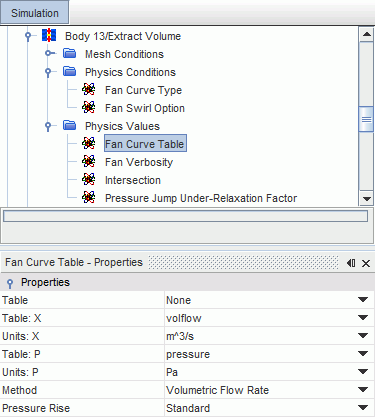Specifying the Fan Performance Curve as a Table
When you set up a fan interface, you can specify the fan performance curve as a table.
Use the following steps:
-
Import the appropriate fan performance curve table into the simulation.
-
Expand the node, and select Fan Curve Table.

- In the
Properties window, set the following properties:
Table Select the fan performance curve table that you imported into your simulation. Table: X Select the column that contains the input variable of the pressure rise function for the selected fan performance table. Units: X Select the appropriate input variable units. Table: P Select the column that contains the pressure data for the selected fan performance table. Units: P Select the appropriate pressure units. Method Select the input variable of the pressure rise function. When you choose the Static to Static option, ensure that the specified fan curve is a decreasing function of the input variable. When you choose the Standard option, ensure that [specified fan curve + ] is a decreasing function of input variable.
Out of the four fan curve method options, only the Mass Average Velocity option is not linearized and is considered to be less robust. The other options apply a different pressure rise to each face at the fan interface. However, for some problems, it can be more meaningful to apply the same pressure rise to all of the faces on the fan interface. In that scenario, you can use the mass averaged velocity options.
Local Velocity Sets the curve as a function of local velocity. This option is based on the velocity normal to the face. This option is the default.
Mass Average Velocity Sets the curve as a function of mass average velocity. Volumetric Flow Rate Sets the curve as a function of volumetric flow rate. Mass Flow Rate Sets the curve as a function of mass flow rate. Pressure Rise Specifies how the pressure rise across the fan interface is defined. Standard The difference between the static pressure downstream and the total pressure upstream of the interface. This is the default option.
Static to Static The difference between the static pressure downstream and the static pressure upstream of the interface.
This definition is the same as the difference between the total pressure downstream and the total pressure upstream of the interface.
The fan curve table computes the pressure rise by linear interpolation between the data points in the table. Outside the intervals, the nearest limit is used.
You can scale the fan curve in temperature as well as in rotation rate. See Specifying the Fan Curve Temperature Scaling.
| Note | For Pressure Outlet and Stagnation Inlet boundaries, the fan does not add swirl velocity, and the operating and data rotation rates are only used for scaling the performance curve. |